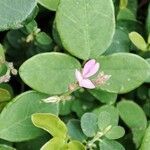Prostrate or repent to ascending, much branched herb; stem angulate, striate, sparsely uncinulate puberulent. Leaves trifoliolate, stipulate, petiolate; stipules obliquely ovate, acuminate, auriculate at base, auricles of the 2 stipules usually overlapping on the opposite side of the stem from the petiole base, puberulent, long ciliate, usually persistent, 2-3.5 mm long, 1.8-3 mm wide; petioles sulcate, long pilose along the groove, otherwise angulate, striate, and uncinulate puber-ulent, 0.9-2 cm long, the leaf rachis similar, 0.2-0.5 cm long; stipels lance atten-uate, striate, ciliate, 0.8-2 mm long; petiolules of terminal leaflets 1-2 mm long, of lateral leaflets 0.8-1.5 mm long; leaflets somewhat uncinulate puberulent and appressed pilose on the adaxial surface with trichomes ca. 1 mm long, moderately appressed long pilose and remotely uncinulate puberulent on the abaxial surface, the margins ciliate, the terminal leaflet elliptic, obtuse at the base and the apex or cuneate at base, 0.9-2.5 cm long, 0.7-2 cm wide, the lateral leaflets obliquely elliptic, rounded at the base, acute at the apex, 0.8-2.2 cm long, 0.4-1.5 cm wide. Inflorescence of axillary and terminal racemes; rachis angulate, striate, uncinulate puberulent, remotely pilose with glandular trichomes; primary bracts narrowly ovate acuminate, striate, puberulent and pilose on the outer surface, puberulent on the inner surface, often reflexed at maturity, 1.5-2.5 mm long, 0.8-1 mm wide, each subtending an indeterminate number of pedicels and each pedicel further subtended by a smaller similar secondary bract borne more or less laterally, 0.8-1 mm long, 0.3-0.4 mm wide; pedicels somewhat uncinulate puberulent and mod-erately pilose with glandular trichomes, 4-8 mm long. Flowers with the calyx minutely puberulent and stiffly long pilose throughout, teeth of the lower lobe slender, the central tooth 2-3 mm long, the lateral teeth 2-2.5 mm long, the upper lobe 2-2.6 mm long, bifid for 0.5 mm of its length; corolla exceeding the calyx, the standard obovate, deeply retuse, the 2 halves of the apex rounded, narrowed to an obtusish base, 3.5-4.5 mm long, 2.5-4 mm wide, the wings oblong, truncate above, auriculate and short unguiculate, 3.3-4 mm long, 1.5 mm wide, the keel petals scythe shaped, narrowed to a tapering base, 3.5-4.5 mm long, 1-1.5 mm wide. Loment short stipitate, the stipe 1 mm long, 7-8-articulate, the articles narrowly elliptic, isthmi almost as wide as the articles, the surfaces strongly and closely reticulate, densely uncinulate pubescent, 4 mm long, 1.5 mm wide; seed rectangular, 2 mm long, 1 mm wide.
More
Herbs, perennial. Stems ascending or diffuse, hooked hairy. Leaves 3-foliolate; petiole 1.5-3 cm, minutely hooked hairy; terminal leaflet blade ovate or broadly elliptic to obovate, 1-4 × 0.7-2.5 cm, lateral ones slightly smaller, both surfaces adpressed hairy, lateral veins 4 or 5, base obtuse, apex obtuse-rounded or emarginate. Racemes terminal or axillary; rachis slender, minutely hooked hairy, laxly flowered, 1-or 2-flowered at each node. Pedicel 3-7 mm, with hooked hairs, sometimes intermixed with straight hairs. Calyx campanulate, ca. 2.5 mm; upper lobes slightly 2-toothed. Corolla pink, ca. 4 mm; standard obovate; wings oblong, clawed; keel obliquely obovate, long clawed. Ovary linear, ca. 3.5 mm; style curved. Legume linear, slender, 2-5 × ca. 0.25 cm, 3-8-jointed, constricted between articles; articles 4-6 mm, 3-4 × as long as wide, hooked hairy. Fl. and fr. Aug-Oct. 2n = 22*.
A straggling, climbing or procumbent herb

